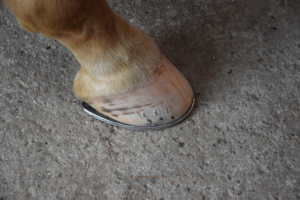
Do todays Reining horses need less wide sliding plates then 20 years ago?
Read how Reining horse farrier and trainer Martin Dümmel picks his shoes:
Stop and Slide
Farriers Journal: How do you pick the correct sliding plates?
Martin Dümmel: I think the biggest mistake in modern reining shoeing is putting overly wide shoes on horses that have no need for that. The shoeing style that was correct about 10-15 years ago is in most cases no longer appropriate today. The long-distance stoppers of the past, which were often referred to as skaters, as they stayed on top of the ground to slide, are gone today. The mechanics of a modern sliding stop is different. The horses attack the ground deeper with their hind legs and are nevertheless more relaxed and round when they stop. The young horses are typically shod for the first time with shoes with no more than a 22 mm web. In rare cases, we go for 25 millimetres. The shoes should help the horses to perform their first stop attempts with ease but should still give them enough grip not to scare them. If they have too much shoe width in the beginning the horses become afraid of moving freely and easily injure their hocks and knees. I rocker the toe at a 45-degree angle to avoid the toe getting caught in the ground during the stop. In the beginning, I align my shoes with the central sulcus of the frog. I don’t think it is good to start rotating the shoes inward when you shoe young horses to prevent the limbs from spreading apart during the stop. First I need to see how the horses stop when they are shod simply and correctly, without modifications. We need to give them enough time to learn stopping before we try to influence the way they stop by modifying their shoes. If you are shoeing for riders on the amateur level it is very important to see how they work their horses and especially how they build up their run-downs. In many cases an incorrectly performed run-down is what keeps the horse from stopping correctly. If we start to influence these cases by modifying the shoes we often cause damage to the legs.

